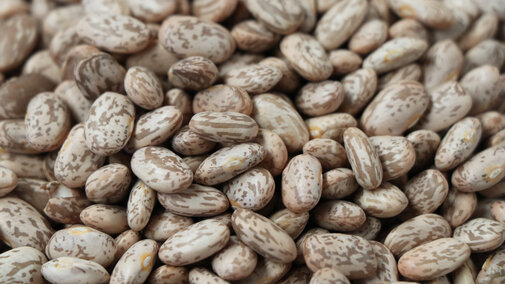Dry edible beans such as pintos, great northern, and black beans are a valuable commodity grown in western Nebraska and eastern Wyoming. However, hail and drought can easily reduce bean quality and the feasibility of harvest for the rigorous human consumption standards. So the question becomes, when dry edible beans are not suitable for human consumption, what options are available?
What are lectins?
Nebraska ranks second and Wyoming eighth in national dry bean production.
Dry edible beans contain a compound called lectins. Lectins are a type of protein that, when not properly denatured by heat, can damage the intestinal wall, impair digestion and nutrient absorption, and create immunosuppression issues. This presence of lectins impacts the amount that can be fed to beef cattle.
What if I was able to harvest my crop, but the beans were rejected for human consumption?
Dry edible beans have great binding characteristics which make them a great ingredient in pelleted or cubed feeds such as protein supplements. Research from Kansas State University has indicated that the heat produced during pelleting is not enough to denature the lectins. However, because the beans will likely only be included at 2% of the dry matter in the pellet formula, and the pellets will likely be less than 20% of the diet dry matter, the lectins will likely not be an issue. Therefore, selling the beans as a binder to a feed company who makes pellets might be an option.
Selling the beans to a feedlot to incorporate into a finishing diet might also be an option. However, there are some precautions when including dry edible beans in a beef cattle finishing diet. Research from Colorado State University reported that finishing cattle fed up to 15% dry edible beans on a dry matter basis had reduced intake, and poor feed efficiency and gain. That particular experiment was terminated after 30 days due to poor performance. In a subsequent experiment the researchers noted steers fed 0.5% and 1.0% dry edible beans gained better than those fed 2% (dry matter basis) while feed efficiency was similar. This suggests the anti-nutritional properties become evident at 2% of the dry matter in finishing diets. A factor to consider when pricing cull beans is that a Colorado State study found pinto beans to be 44% of the value of corn in a lamb study.
Growing calves are traditionally on a high roughage diet and supplemented with protein and energy. Research from the University of Nebraska indicated growing calves did not experience reduced performance compared to a control diet when dry edible beans were included in a roughage-based diet at 5% and 7.5% of the diet dry matter. Performance was reduced when dry edible beans were included at 15%.
What if the beans are not worth harvesting? Is there value in bean forage?
When a crop is to be used for something other than its intended use, producers need to first check with government agencies and insurance companies to evaluate any stipulations for that use.
An immature bean plant does have some forage value but harvesting it for forage, either mechanically or by grazing, needs to be economically evaluated first. The tonnage available must be evaluated against the cost of swathing and baling, chopping and packing, or building fence.
Immature black bean whole plants after a frost were evaluated at the University of Nebraska. The in vitro dry matter disappearance (IVDMD) similar to total digestible nutrients (TDN) was 66%. As a reference, good quality corn silage is about 70% TDN and wheat straw is 45% TDN. The crude protein on the immature black bean plant was 11.5%, which is more than adequate to maintain rumen function in the beef cow.
Summary
Dry edible beans impacted by drought and hail may have some salvage value for livestock feed. Consider the cost:benefit ratio of all alternative uses for the crop before making a decision. University of Nebraska extension personnel are available to help with ration balancing if dry edible beans are to be considered for livestock feed.
Literature Cited
Jenkins, K.H. 2010. Feed value of alternative crops for beef cattle. NebGuide 2036. http://extensionpublications.unl.edu/assets/pdf/g2036.pdf
Maynard, E. J., G. E. Morton, and H. B. Osland. 1931. Colorado drylot fattening rations for lambs. Colorado Experiment Station Bulletin 379:46.
Rush, I., B. Weichenthal, and B. Van Pelt. 1998. Cull dry edible beans in growing calf rations. Nebraska Beef Cattle Report MP 69, p 43.
Stanton, T.L. and D. Schutz. 1999. Cull Great Northern Beans for finishing steer calves. The Professional Animal Scientist 15:253-257. doi.org/10.15232/S1080-7446(15)31771-X

